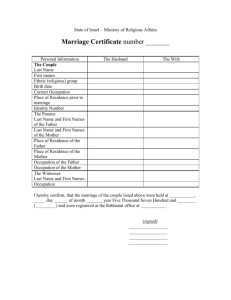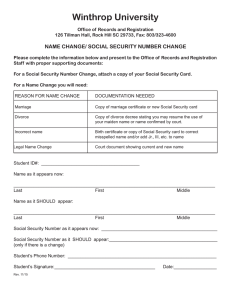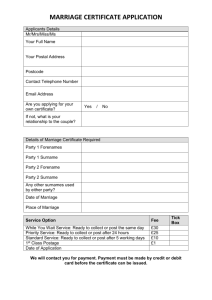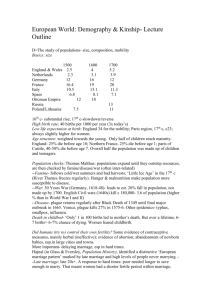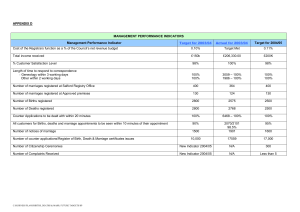REPORT OF CIVIL REGISTRATION AND VITAL STATISTICS SYSTEM IN MADAGASCAR
advertisement
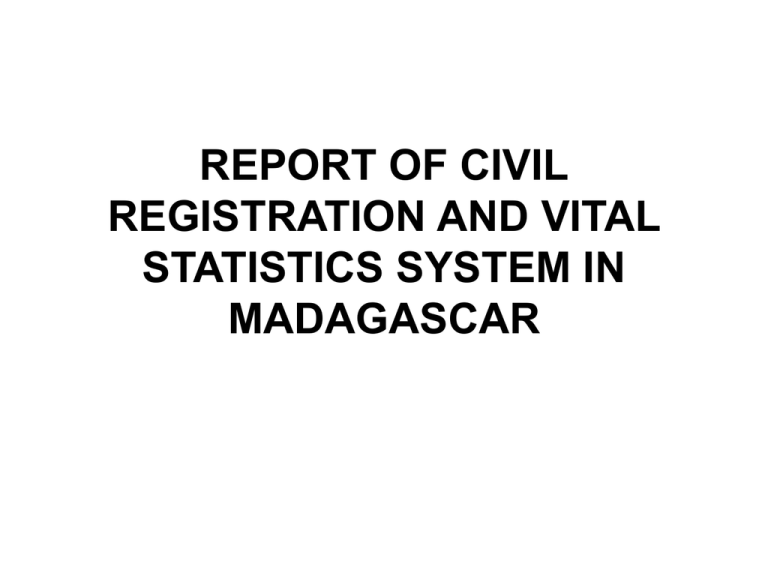
REPORT OF CIVIL REGISTRATION AND VITAL STATISTICS SYSTEM IN MADAGASCAR INTRODUCTION • The events relating to civil status of each citizen are registered in each municipality, as center status according to law No. 61-025 of 9 October 1961 on civil status. A circular of application is appended to this law with models for the registration of each category of act of civil. • There are 1500 municipalities, called commune in the territory of the Republic of Madagascar I - Competent authority to record the events of the civil • The Mayor is the Chief Administrative Officer of the Commune, and the burden of local interests. • The Mayor and deputies are officers of civil status. • The officers of civil status are only competent to receive and keep the proceedings of the state civil. • The officer had standing to receive the statements and acts that draw within their constituency. II - Duties of officiers of state civil • The officer is responsible for: 1 To receive declarations of birth and to draw up act; 2 To obtain concurrently with the officers and notaries public authorities, the recognition of children born outside marriage and to establish act; 3 To observe the marriage and to establish act; 4 To receive declarations of death and prepare act; 5 Receive acts of adoption and rejection (adult); 6 To keep the registers, ie: To include all acts that he has received: - Transcribe some acts received by other public III – The events of the civil • • • • • • • • Birth Death Marriage Adoption Recognition of child born outside marriage Act rect Judgment of divorce or marriage annulment Judgment of name change IV - The supervisory authorities The verfication and monotoring the fuctioning of civil status is exercised by : • judicial authorities : prosecutor at the court of First Instance or the judge delegated by him • State representative at the district level under the control of legality. This authority also responsible for the administrative census and the establishment of database of the population. V - The registration system of civil In each center status, it is required in duplicate separate registers: a) For births and recognitions; b) For deaths; c) For marriages; d) For adoptions and reject 1. The rules common to all acts of civil The statements are received: - For births by the officer's place of birth; - For deaths by the place of death; - For weddings, for the venue of the celebration; - For adoptions and discharges, by that of the habitual residence of the adoption or rejection; - (Law 66-017 of 05.07.66) for recognition by that of habitual residence of the person who recognizes the child; 2. The rules of each category of act of civil a) Birth certificates • • • Statements of birth should be made within twelve days of birth. The birth certificate should state the date, time and place of birth, sex and the names and surnames that are given the full name, age, place of birth, occupation and residence habitual father and mother and, where appropriate, name, occupation and residence of the registrant. The birth certificate is drawn up immediately and signed by the declaring and the officer b) Death certificate Any act of death include: the date, time and place of death; the name, sex, date and place of birth,profession and home of the deceased; the full name, occupation and residence of his father and mother; the names of spouses, if the deceased is married; degrees if appropriate, the full name, age, occupation and address of the registrant and, where appropriate, its kinship with the deceased, or the fact that he has witnessed the death. It is given on the records no indication of the circumstances of death unless the identity of the corpse remains unknown. The authority responsible for issuing burial permits will collect the information necessary for the declaration and the establishment of the death, it will forward information to the civil jurisdiction. c) Acts of marriage • Marriage can be contracted in one of two ways: - Celebration by the officer or, - In traditional celebration, followed by civil registration (only in rural areas) • The marriage will contain: 1 the name, occupation, age, date and place of birth, parentage and residence of the spouses; 2 nationality declared by the spouses on the inquiry made to them by the officer; 3 a finding by the officer that the contractors have said or agreed to take to spouses; 4 names, ages, occupation and residence of witnesses d) Act of adoption The act of adoption must indicate: full name, date and place of birth (approximate age when the date of birth can not be listed), affiliation, occupation and residence of the adopter; full name, date and place of birth (approximate age when the date of birth can not be listed), affiliation, occupation and residence of the adoptee; e) Act of rejection All Malagasy nationals are allowed to reject a child, but they must first be authorized by the presiding judge of their residence to the statement of rejection. Accordingly, the registration officers will not receive a rejection only on presentation of the authorization granted by the presiding judge. f) act of recognition of children born outside marriage • The act of recognition of a child born outside marriage is registered to date. • Mention is made of the act of recognition on the sidelines of the birth certificate, if one exists, and it is to notice within three days, the clerk of the court's place of birth. Marginal references The endorsement is a marginal advertising intended to clarify the legal position of the holder of an act of civil status. a) The acts that must be marked in the margins On the sidelines of birth: acts of marriage, adoption rejection, death, recognition judgment of divorce, annulment of marriage, denial of paternity, Judgment change of name, judgments or decisions establishing paternity or adoptive. Regarding divorce, the officer on registers which has been the transcript of the decision made on the sidelines of the marriage and birth certificates of the parties and give notice of divorce refer to the Registrar of the court. b) The particulars essential to include The date and nature of the event, on court judgments, date and the court has made. 5. Judgments of supplementary civil • When the birth or death has not been made within the period prescribed by law, anyone who wants to replace the lack of a birth or death must bring to end this action in the court of first instance. • The court makes a ruling supplementary birth certificate or death as appropriate. • Trial supplementary birth certificate or death must be entered in the center of civil status. V - The factors that hamper the production of vital statistics from civil registration • According to the Civil Status Act, each center civil forward to the Ministry of Justice every five years a table showing all categories of acts recorded. • In principle, this table would allow the Department of Justice to establish the statistical data on the events of the civil status. For several years, centers civil doesn’t send the table in question to the Ministry of Justice for various reasons : • Inadequate budget of Commons for the costs of shipments, • Insufficient number of administrative staff compared to the volume of work to do on civil status • the registration officers have not received adequate instructions to set the table • administrative and judicial authorities responsible for control and supervision of civil status are not available to the proper control because they are inundated with other work at their charge • Moreover, registration officers no longer send the statistical sheets to the National Institute of Statistics for various reasons: • Previously, statistical sheets were provided free by INSTAT. Currently, the centers of civil status must buy these sheets on the budget for the town which is insufficient. • In some centers civil status, these sheets still exist and are satisfied but they are no longer forwarded to the Central Bureau of Statistics because the shipping package is then paid before the shipment was free • On the organizational level, it was found that the malfunctioning center for a civil cause the problem of payment of salaries of secretaries of state civil. Therefore, they are not well motivated to do their work regularly VI – Barriers to the registration of events in the civil Some events in the civil status are not registered at the center of the civil: births, deaths, marriages traditional The reasons : Particularly in remote rural areas centers of civil status or isolated. The period of 12 days prescribed by law for the birth and death is considered too short The rural population is not sufficiently aware of the importance of birth and death the rural population is not aware of the proceedings on the registration of traditional marriages at the town hall VII – PLANS TO IMPROVE CIVIL REGISTRATION • Since 2004, the Government had launched a rehabilitation program in the registration of births • The program's objective is to implement all means to ensure that births are registered within the legal deadline. • The implementation of the program is under the coordination of the Ministry of Interior and the Ministry of Justice with the collaboration of several departments Actions already undertaken • The establishment of a local committee for monitoring the registration of births, • The relaunch of administrative and judicial control civil status • Reform of the law: thus the reporting period of 12 days is extended by 45 days. In remote rural areas or isolated, a special procedure for registering births are created • To facilitate the registration of births and encourage people to register births • The registration officers are currently receiving training and instructions. To this end, they receive training on how to respect for escalations data events of the civil authorities. Registration officers are currently receiving training and instructions. • Children who were not registered at birth are being recorded by means of issuing judgments supplementary birth certificate by the courts • The process of implementing the program begins with the identification of unregistered children. • The implementation of this program is made with the technical and financial collaboration of UNICEF, UNDP and in collaboration with civil society and NGOs
